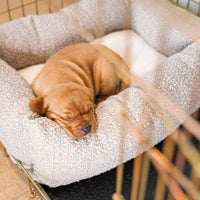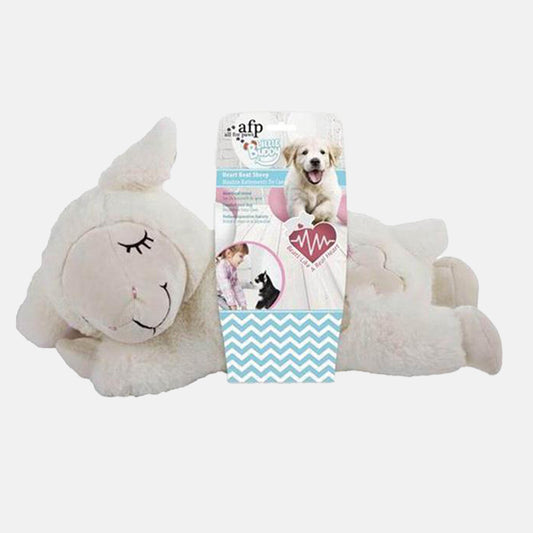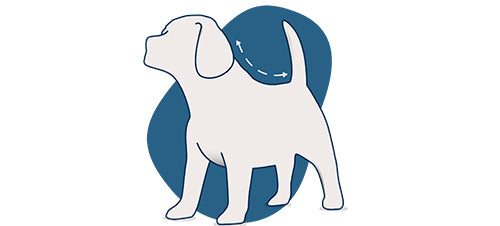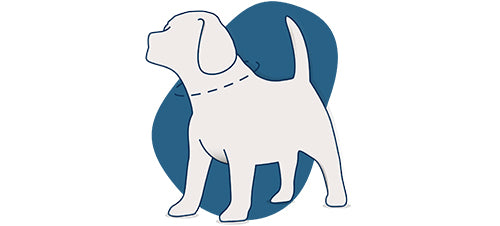When you are about to get a new puppy, it can be difficult to know exactly what you should get them. After all, many puppies can be quite destructive and so you often don’t want to spend a fortune on beds and dog toys until they are a little older and better trained. So, we have put together a great and useful guide on what you should consider choosing for your little pup.
New Puppy Shopping List
First Puppy Bed
Their first bed should not be too expensive, as accidents are bound to happen, but it should still be supportive, cosy, and settling, so that it feels just like a lovely and comfortable nest. Puppies need to feel safe and protected, so a bed that encapsulates all of this is very important. One of the best puppy beds is the Cosy & Calming Puppy Crate bed or our Grow With Me Beds. The latter is a cosy fleece design with an inner ring that is not only perfect for puppies to snuggle into, but can also be removed as puppy grows so it will last beyond the first couple of weeks.
Our Cosy & Calming Puppy Crate Bed fits in exactly one half of your puppy's crate. When puppy has grown, is toilet trained and you've swapped this small bed for a full crate set, you can use this bed around the house as a stand-alone dog bed.
Puppy Scent Blanket
Studies have shown taking home a blanket or comforter with the scent of your puppies mum on massively helps them to settle when you first bring them home, which is why we developed our puppy scent blankets. They’re perfect for putting in with the litter and then bringing back home with you to help settle your puppy. They come in matching fabrics to our puppy beds one one side and the softest fleece on the other so are perfect for snuggling up to
Puppy Food & Water Bowls
Feeding your puppy is an important part of your puppies routine. Having at two bowls for food and water is a must, you might even buy a third so you have separate bowls for dry and wet food. We love the Mason Cash Paw Print bowls for puppies, they’re just the right size for tiny puppies! We'd also suggest buying your puppy a travel bowl such as our Beco travel bowl. These handy, pop-up bowls are the ideal travel companion, even for short journeys, so your pup always has somewhere to drink on the move.
The Best Toys
KONG toys are tough and durable, which makes them perfect for puppies who are teething. Wearing your puppy out mentally is just as important as walks, these toys from KONG are great because you can fill them with treats, wet food or even peanut butter and they will help keep your puppy entertained for long periods of time and keep them stimulated. You can also fill them with treats to Also their tough build mean they are likely to last much longer than most others.
Plush toys are perfect for dogs who like toys that are soft and cuddly, and carrying breeds are sure to be very fond of this toy. If you pair this with a few other soft toys and a toy box, your puppy will never get bored. Switching toys out regularly keeps them stimulated and entertained after all. We particularly love the Heart Beat Sheep, it mimics mums heart beat so is great for settling nervous puppies when they first come home.
Puppy Collars, Leads & Harnesses
Lead training is one of the most important parts of a puppy's development. It might not be the first thing they learn, but it's important to have the accessories ready for when the day comes for their first trip outside. Some our favourite walking accessories are those by Ruffwear and Cocopup. Ruffwear make super durable, practical walking accessories in a range of stylish colours. One of the best starter harnesses is the Front Range harness which we love for puppy lead training. It comes in sizes small enough for the smallest chihuahua and is fully adjustable so you can be sure it offers all the comfort and support your puppy needs when they're learning to walk on a lead. Check out the matching collars and leads as well as the stylish harnesses for when they grow up!
Our Lords & Labradors Essentials Walking Accessories have been designed here in our Lincolnshire based workshop, they’ve been tested on all our resident dogs and come in 7 sizes so you can be sure to get the right fit. They’re handcrafted in Italy using the finest Italian leather and even have matching leads so you know your puppy will be the most stylish one in the park
Since it became law for all puppies to be microchipped by 8 weeks old some people have been confused whether you still need an ID tag on their collar, it’s a legal requirement to have both! Your puppies ID tag will need your name and address on it, the Kennel Club Good Citizen Scheme also recommends that you have an up to date phone number on there so that if your dog does get lost they can get back to you as quick as possible.
Puppy Grooming & Shampoos
Puppies are bound to get mucky sooner or later, and so being prepared is important. Here at L&L we have specially formulated our own puppy shampoo and cologne, our PetPlex Puppy Purifier Collection. It has a gentle formulation which is both silicone and paraben free and is to a professional grooming standard, so you can be sure that it won’t irritate your precious pups skin, the aloe vera in the formulation will also help to soothe . It also has the most gorgeous baby powder scent which will keep them smelling fresh for days, the cologne is great for a quick spritz between washes!
We designed our bamboo drying mitts especially for wriggly puppies after a bath or a wet walk, it makes drying them so easy, saving you a good deal of time and effort – which is perfect for the muddy Autumn and Winter months.
Puppy Crate Training - Helping Puppy Feeling Safe
Your puppy needs to feel safe, and that is why so many of them love being in a crate. It replicates their dens in the wild and acts as their own space to retreat to. Crates, when used right, are a safe space for your dog and can really help with teaching your dog routine and toilet training. Not sure how to crate train? Check out our crate training guide written by one of our pet experts, it has everything you need to know about crate training your puppy!
If your pup loves their crate, then getting a crate cover can help to enforce the safe feeling of being in a cave that they are instinctively searching for. Our crates perfectly combine practicality and good aesthetics and are ideal for puppies as they can easily be machine washable too. So, both the puppy and the human benefit!
Puppy Training Treats
Puppy treats are a great way of encouraging good behaviour and training in general, especially if you’re using a positive rewards based training method like clicker training! They can be used to help crate training as well as teaching commands. We love the Innocent Hound Puppy Training Treats, they are hypoallergenic and grain free treats which are made with 80% fresh British lamb!
Car Seats
When travelling with your puppy it’s a legal requirement to have them secure, whether that’s in the boot in a crate, using a seatbelt restraint or with a car seat. This is to help keep both you and them safe if a car accident unfortunately happens! The best way to travel with your dog will depend on their size, bigger dogs are usually happier in the boot where they have a little more space whereas smaller dogs tend to like snuggling up in a car seat. We have curated a collection of the best options for travelling with your pet so why not have a look?
Puppy Pads
Accidents happen, especially in the first few weeks of having a puppy whilst they’re still toilet training. Puppy training pads are great for putting by the door whilst they’re still learning, you can put them in the other side of their crate to their cosy and calm or you can use them to clean up any accidents. Our puppy pads have 5 layers so are super absorbent, they also help to neutralise any smelly odours
Puppy Pens & Gates
It’s not possible to watch your puppy 24/7, that’s where puppy pens and gates come in. Gates are used to block doorways and stairs to help keep your puppy in one area of the house, our gates are in a stylish wooden finish so will look a part of your home rather than detracting from your interior.
Puppy play pens are perfect for building up your puppies confidence whilst you’re out. They contain them in a safe space whilst they’re still learning their boundaries, it stops them from getting into any mischief! We have both wooden and metal playpens. Our metal playpens are great because they can also attach to your crate, this means your puppy still has access to their safe space but also has room to play.
Puppy Packs
Still not sure what to get? Our puppy packs are a great place to start. They contain the basics you’ll need to collect your puppy which you can then add to as you figure out what’s right for you and your puppy.
Creating Your List
Of course, the list in this article is a general one filled with our top suggestions. Every puppy is different, and this list might not be quite right for them. If you would like us to put together a personalised shopping list for your puppy, make sure you give us a call or use our live chat services. We are always happy to help and can’t wait to help you choose the best products for your pup.








































































.jpg?v=1723712924433&options=)
































